Photogallery
Login
Archives
ABSTRACT
Assessment of clinical and microbiological status of dental implant And adjacent teeth
Himangi Dubey, Nida Ansari, Vidhi Srivastava, Nand Lal, Umesh P. Verma
ABSTRACT
Background: Dental plaque carries numerous bacteria which are harmful for the normal health of gingiva. Dental implants are widely used in dentistry. There are various factors which affects the outcome of implant therapy. The present study was conducted to assess the presence of bacteria around dental implants. Materials & Methods: The present study was conducted on 20 patients who received dental implants in the last 2 years. They were divided into 2 groups of 10 patients each. Group I comprised of patients in which subgingival plaque sample was obtained around dental implant and group II had those patients in which subgingival plaque sample was obtained around teeth adjacent to dental implant. Samples were subjected to microbiological analysis using PCR. In all patients, plaque index, sulcus bleeding index and probing pocket depth was measured. Results: In group I, mean plaque score for P. gingivalis was 2.16 and in group II was 1.78. The difference was non- significant (P> 0.05). Sulcus bleeding score was 1.85 and 1.02 in group I and group II respectively. Probing depth was 4.46 and 3.83 in group I and group II respectively. The difference was non- significant (P> 0.05). The mean plaque score for A. Actinomycetemcomitans in group I was 2.6 and 2.4 in group II. Sulcus bleeding index (SBI) was 2.1 and 2.2 in group I and group II respectively. Probing depth was 4.5 and 4.41 in group I and group II respectively. The difference was non- significant (P> 0.05). The mean plaque score for Prevotella intermedia in group I was 2.1 and 1.8 in group II. Sulcus bleeding index (SBI) was 1.4 and 1.1 in group I and group II respectively. Probing depth was 4.2 and 3.7 in group I and group II respectively. The difference was non- significant (P> 0.05). Conclusion: Microbiological analysis found A. Actinomycetemcomitans, P. intermedia and P. gingivalis in both groups. The qualitative assessment of these bacteria between both groups found to be similar.
[Full Text Article]
